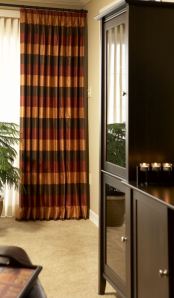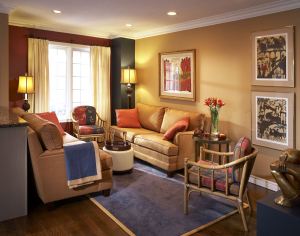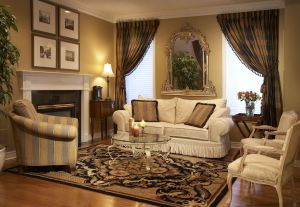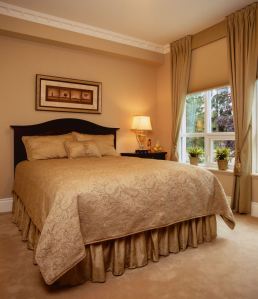In this series, we’re going to explore how to incorporate colourful original art into your interiors. Even if you have very neutral, monochromatic interiors, you can fall in love with artwork that is much more exuberant than your usual palette, and this may leave you wondering how to showcase this piece in your home. Or perhaps, you have walked away from such a piece in fear, not knowing where you could possibly work it into your space. There are art collectors who feel that one can put all art together, and that a room should never be decorated around the art, nor should the art match the interiors. This series is not for them, because they have no fear of putting art they love in any room they wish. For the rest of you, fear no more — help is on the way!
Blue Flower, by Kathy Poitras, acrylic on canvas, 30” x 30”
Here we have a vibrant floral still life, which at quick glance, is very blue. However, the first step to finding a home for this piece is to look at all the other colours that are present: café brown, sunflower yellow, violets ranging from almost grey to deep plum, and many shades of green and blue-green. Are any of these colours present in your home in any quantity? Do any of these colours go with the colours that are in your home?
There are many wall colours that would work as a backdrop for this painting. Here are a few suggestions from Benjamin Moore:
- Neutrals: HC-78 Litchfield Gray, OC-4 Brandy Cream
- Blue/Violet: CC-830 Stratford Blue, CC-920 Yukon Sky
- Green: 2052-40 Blue Spa,
- Gold: HC-8 Dorset Gold, HC-12 Concord Ivory
(To view these colours online, go to benjaminmoore.com, select “For your home”, then “Explore colour”, then “Virtual fandeck”. Or visit your local Benjamin Moore paint retailer.) Do your walls already resemble one of these colours? If so, then you may be able to put a painting like this in your room. But wall colour alone won’t determine whether a painting will come to life in your room. For real pizzazz, you need to extend one or two colours from the painting into other areas of the room, in order to make a connection between the art and your décor.
One way to repeat the colours in the art is in your soft furnishings, rugs, and fabrics. If you already have colourful upholstery, drapery, or a rug that picks up the colours in the painting, then you need do no more. However, if you love these colours but don’t yet have them in the room, then you can add fabrics that harmonize with the art. It may be as simple as adding some bold new toss pillows to your existing sofa.
A quick review of fabrics available through Kravet, (kravet.com), brought up several possibilities. If any of these would work with your existing sofa, or other fabrics in your rooms, then you are well on your way to making this painting work in your home. I found that the fabrics fell into 3 distinct ‘looks’: one was French country, one was a whimsical blue and green palette, and the other was a sophisticated urban blend of brown and blue. The French country look will appeal most to those of you who are comfortable mixing patterns and multiple colours in your rooms. The whimsical blues and greens are all patterns that could be added to an existing scheme to complement the colours in the painting. The brown/blue combinations will appeal to those of you who prefer more neutral schemes.
French Country fabrics:
City Sophisticate fabrics:
Whimsical Green & Blue fabrics:
There are many other fabrics that could work – imagine a tropical paradise for your sunroom, or a little girl’s vibrant bedroom. There is no right or wrong, as long as you are happy every time you see your art in the room that you’ve chosen. Next time you are tempted to play it safe with your art selections, push yourself to be a little more daring, and go for something you really love, even if it scares you a little. You won’t regret it.
Artist Credit: Kathy Poitras, www.yessy.com/4expression/paper.html, 416-519-4345






















 Quality custom window treatments are crafted by skilled workrooms. They are always luxuriously full – never skimpy – and the weighted corners in the hems of side panels, insure an even, continuous hemline. Lining also plays a major role in custom designed window treatments, and there are different types for different applications. The most basic function of lining is to protect the drapery fabric, and your furnishings, from the sun. Some linings are little heavier, for lightweight fabrics like silk, while other linings completely block the sun for sleeping. It’s also important to consider how a lining will affect the overall draping of the fabric.
Quality custom window treatments are crafted by skilled workrooms. They are always luxuriously full – never skimpy – and the weighted corners in the hems of side panels, insure an even, continuous hemline. Lining also plays a major role in custom designed window treatments, and there are different types for different applications. The most basic function of lining is to protect the drapery fabric, and your furnishings, from the sun. Some linings are little heavier, for lightweight fabrics like silk, while other linings completely block the sun for sleeping. It’s also important to consider how a lining will affect the overall draping of the fabric. 




